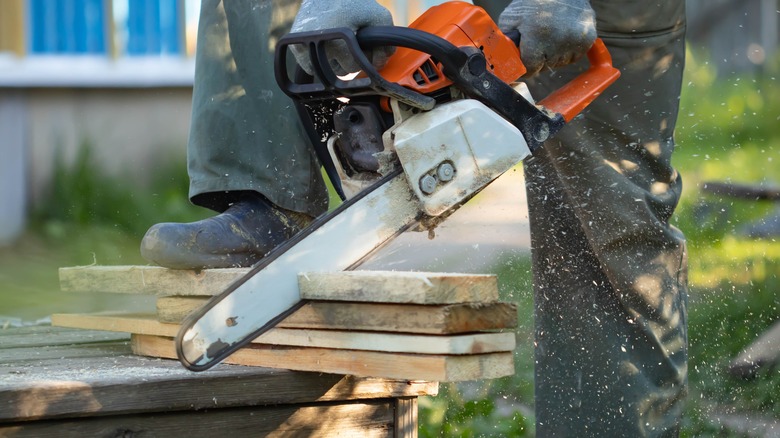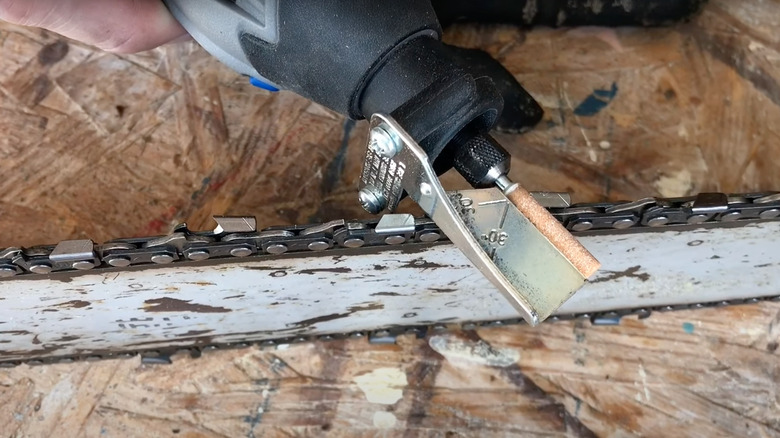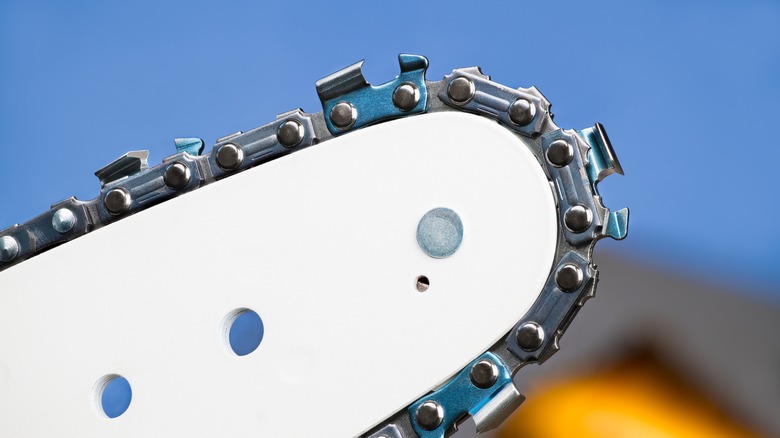How To Sharpen Your Chainsaw With A Dremel (& Mistakes To Avoid)
You know what they say about dull knives: They're much more dangerous than sharp ones. Well, the same applies to your chainsaw, except the stakes are a little higher, because rather than a standard kitchen knife, you're operating a giant gas or electric powered saw capable of slicing right through trees. At worst, using a dull chainsaw can cause kickback — one of the leading causes of chainsaw incidents. At best, a dull chainsaw is much less efficient than a sharp one, requiring more force for it to work and more overall effort on your part.
While many choose to sharpen their dull chainsaw with a file, you can also quickly sharpen a chainsaw to keep it cutting cleanly with a Dremel and chainsaw sharpening attachment. A Dremel is a power rotary tool that every homeowner should have, thanks to its many different uses, including crafting, removing rusted screws, and, of course, sharpening chainsaw teeth. To use your Dremel to sharpen your chainsaw, you'll simply need to place the grinding stone attachment between the chainsaw teeth at the proper angle, turn it on, and move it back and forth between the teeth.
Keeping your chainsaw sharp is an important part of using a chainsaw safely, and there will be signs if it's getting dull. If the chainsaw is smoking, creating big clouds of dust, or just cutting slower than usual, odds are it's time to sharpen your chainsaw. Some even recommend sharpening your chainsaw each time you refill the gas tank, just to be safe. The good news is, using a Dremel makes sharpening your chainsaw quicker and easier, and here's how to do it.
How it's done
First things first, you want to make sure your chainsaw is nice and clean before you start to sharpen it. You can do this with a rag or brush, and be sure to remove all of the grease and dirt. Not only will this help you see the parts that need to be sharpened, but it'll also keep your tools cleaner. Once the saw is clean, you'll want to choose the proper grinding stone attachment that matches the pitch of your chainsaw, then attach it to the Dremel. The pitch is the distance between rivets, and you can find this number either printed on the blade itself or in the user's manual for your chainsaw.
After you've attached the proper-sized grinding stone and the sharpening angle guide attachment, go ahead and mark a starting tooth with a pen or marker so you know when you've finished sharpening all the teeth. Then, slide the grinding stone against the tooth with the edge of the angle guide level with the top of the tooth, and the 30 degree line level with the chain. Once it's in position, go ahead and turn on your Dremel, and run the sharpening stone back and forth against the tooth for about ten seconds or until the tooth is sharp. Repeat the process on all of the teeth until you make it back to that initial black tooth you marked as the starting point, and your chainsaw will be properly sharpened and ready to go.
Common mistakes to avoid
Chainsaw chains don't last forever, and you can only sharpen them about 10 times or so before you'll have to replace the entire chain. With the extra power of rotary tools like a Dremel, it's possible to damage your chain while sharpening it, and further diminish its lifespan. One of the easiest ways to do this is to allow the teeth to overheat while you sharpen them. When the teeth get overheated, the heat can completely alter the edge of the blade, causing it to become soft. To avoid this, keep an eye on the color of the tooth, and make sure it doesn't turn blue. If you're working with a particularly dull tooth, consider taking a break halfway through sharpening it to allow the blade to cool down, and then come back to it later.
Another common mistake to avoid when using a Dremel is sharpening at the wrong angle. This can alter the shape of the teeth and ruin your edges. The best way to avoid this is to use your sharpening angle guide attachment. This isn't something you want to just eyeball!
Finally, in order to avoid any safety mishaps, you'll want to be sure to use the proper safety equipment when operating your Dremel. It's important to always wear safety goggles when using the rotary tool, to protect your eyes from flying debris and dust. A pair of gloves doesn't hurt either, to avoid nicking your hands on the blades you're sharpening, and it's a good idea to either wear a dust mask to avoid inhaling particles, or be sure to work in a well-ventilated area.


